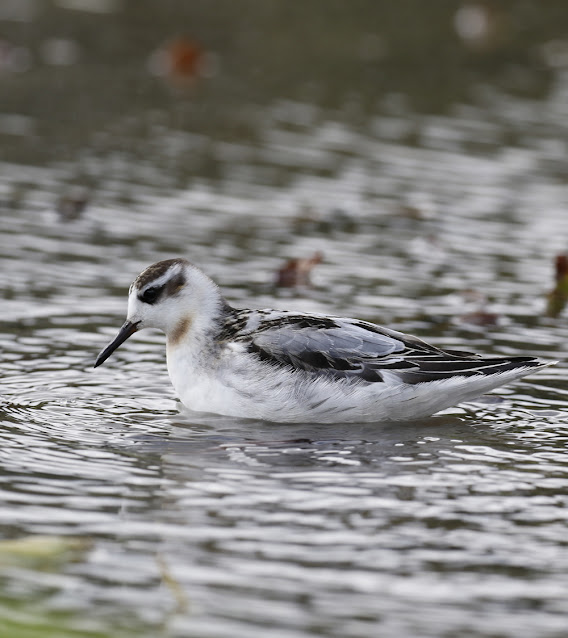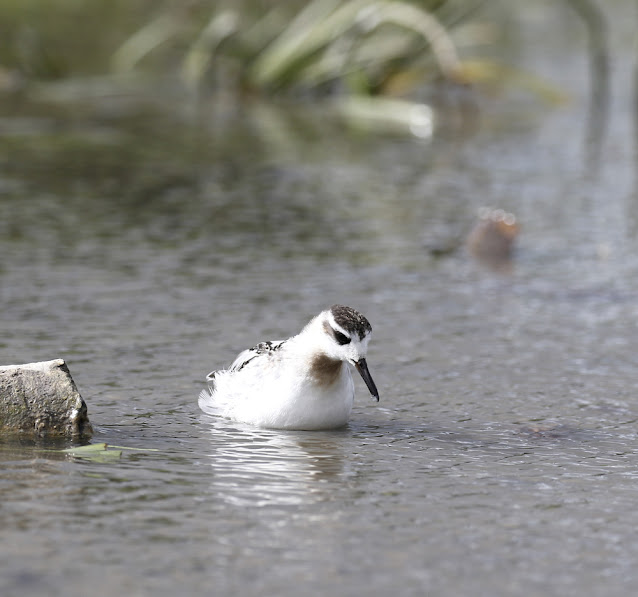The strong westerly winds of the last few days have had birders longingly checking their pagers and phone apps. for any reports of a major ornithological rarity being blown across the Atlantic to these shores. So far only a White throated Sparrow, which arrived in Shetland a day or two ago and a Red eyed Vireo at Nanjizal Valley in Cornwall yesterday, have been the only American representatives to make it across the Atlantic.
Yesterday, reports of Grey Phalaropes, always a bird guaranteed to arrive at this time of year on the back of gales, strong winds and stormy conditions began to filter in. A trickle that became, today, with the gale force winds sweeping Britain, a positive deluge, as in excess of at least sixty displaced 'Grey Phals' were reported from all over Britain, sheltering at various coastal localities, inland lakes or reservoirs.
Driving home from Banbury mid morning I discovered via my RBA app that a juvenile Grey Phalarope had been found on a small lake, just forty minutes drive north from my home, in the neighbouring county of Warwickshire. The lake in question lay in the grounds of Charlecote Park, the eight hundred year old ancestral home of the Lucy family and now owned and administered by The National Trust, with the Lucy family descendants still living in a private wing of the House.
 |
| The Lake. Not quite the Atlantic but for the Grey Phalarope surely a life saver |
 |
| Fallow Deer |
At first it was skittish and flew fifty metres up the lake as I approached which is unusual for a phalarope, as normally they are tame, often ridiculously so. I followed and this time was more circumspect and very slowly edged closer. The phalarope was now feeding amongst some short green reeds and appeared more inclined to allow me to come nearer. I sat down on the grass to minimize my profile and it seemed content with this and carried on with its relentless search for food.
This individual was in a transition of plumage. A combination of grey, brown and white. It was moulting from the predominantly streaked brown upperparts and white underparts of its first few weeks of life to the grey and white plumage it would carry for its first winter at sea. The brown juvenile feathers contrasted with the fresh silvery grey first winter feathers appearing on its upperparts. It was so young that its throat and upper breast were still washed with an orange brown tint and the crown of its head was streaked brown and yet to show any signs of moult into its grey winter plumage.
Like all of its kind it was forever active, swimming close to the bank, twisting and turning, dipping its bill incessantly into the water to consume some tiny morsel of food. Occasionally it would wade in the shallower water, still feeding but mainly preferred to swim and obviously had a preference for this more sheltered end of the lake.So at home on water, it even sat on the water and preened, adopting contorted positions as its delicate lightweight body was blown by particularly violent and unexpected gusts of wind across the water, its feathers splayed in disarray by the strength of the wind.
Grey Phalaropes breed in the high Arctic, from northern Siberia, Alaska, Canada, Greenland and Iceland. They normally migrate entirely over the sea and shun crossing land, only coming to land to breed or, in this case, when blown inland by vicious winds such as have been present in the Atlantic for the last few days.
Their winter plumage mirrors the colour of the Atlantic, grey and white and with the wind turning the waters of the lake into turmoil it must have been re-assuring to the phalarope which would normally experience similar if not even more extreme conditions in mid Atlantic.
I remained where I was sat on the grass and allowed the phalarope to slowly work its way towards me and eventually it was within four feet of me, busily feeding on the water right by the very bank side I was sat on. It showed not one jot of alarm now but if I moved it swam hesitantly further out onto the water, with many an anxious backward glance but never strayed too far from the sheltering bank.
I remained for a good hour, watching and taking photographs of this feathered waif, thrown unceremoniously off course by the strong winds at sea and now being similarly buffeted by the strong wind, here, in the very heart of England. Like many of its similarly disoriented fellows it will remain for a few days to feed and regain some strength and then presumably will lift off from its temporary home and fly across England and far out to sea, instinctively following a course that will take it southwards and across the Equator, down to the rich upwellings of the Benguela Current, off southern Africa. Quite a journey from landlocked Warwickshire!
Many will not make it and succumb on the way, others have probably already died out at sea in the recent storms and these birds blown inland are a fortunate few to have found somewhere, as near as possible to their normal winter habitat, on which to take temporary refuge and recover their strength for the long journey that faces them.
I do hope this tiny bird, that I sat within feet of, makes it to South Africa. I will think of it, tossing on the endless waves, far from any land, as I lie in bed listening to the wind and rain through the winter nights.







































No comments:
Post a Comment